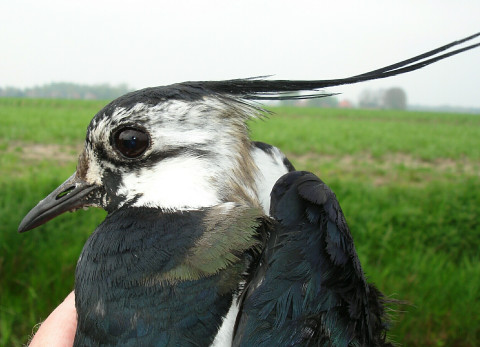Frisian lapwings fan out across Europe in winter

Frisian lapwings fan out across Europe in winter
Northern lapwings are easy to spot during the breeding season, with their noisy aerial acrobatics. But as research led by the Netherlands Institute of Ecology (NIOO-KNAW) shows, lapwings that breed virtually next to each other in spring may spend their winters thousands of kilometres apart. As a survival strategy, it's not enough to stop the species' ongoing decline.
Lapwings aren't full-time herd animals. They spend half the year in a breeding colony, but the researchers found much to their surprise that some will stray as far as Ireland, Spain or even Morocco to overwinter. Others stay close to their breeding grounds all year around: a marked contrast in migration strategies.
The researchers have published their findings in the Journal of Avian Biology. They used geolocators - miniature data loggers that record light intensity - to track lapwings from a colony in the Northern Dutch province of Friesland. They also used colour rings, to be able to recognise individual birds when spotting them in the colony.
By carefully monitoring the tracked birds in the colony, the researchers found that females that spend the winter closer to their breeding grounds were able to breed earlier, giving their chicks a possible advantage.
Another thing they found was that despite the sometimes huge differences between 'neighbours', lapwings tracked for several consecutive years appeared relatively faithful to their chosen wintering area, and consistent in the timing of their migration.
Species in decline
"The large variation in migration strategies found even within a single breeding colony should buffer negative effects along the route and in the wintering areas", explains NIOO-researcher Götz Eichhorn. "The fact that lapwing populations are, nevertheless, in strong decline suggests deteriorating conditions on a very large scale, particularly in the breeding areas."
Lapwings are in decline throughout Europe. In many cases, the number of breeding birds has fallen by as much as 30-50% over the past 30 years. "In the hope of raising attention, the lapwing was even named ‘Bird of the Year 2016’ in the Netherlands", adds Eichhorn.
NIOO's own Centre for Avian Migration is one of the organisations trying to find explanations for the lapwings' decline - information that could also be important for other species sharing its habitat and problems.
"By now", says Eichhorn, "scientists agree that reduced reproduction rates are the chief driver for the decline, as a response to past and continuing intensification and industrialisation of farmland and agricultural practices. The fact that lapwings are still hunted in significant numbers in southern Europe adds to the problem."
Year-round tracking
The research focused on a breeding colony at Nij Beets in Friesland. 'Citizen scientist' Willem Bil offered assistance, with his intimate knowledge of the Frisian study site, and is credited as co-author in the Journal of Avian Biology.
Capturing the lapwings - and recapturing tagged individuals in particular, in order to retrieve the data - proved quite a challenge. But after three years of field work, the researchers had successfully tracked eight northern lapwings year-round. Three birds were even tracked for multiple years.
The geolocators, which were attached to leg-rings, recorded light intensities in order to determine dusk and dawn times. From these, geographical positions were calculated: day (night) length determines the latitude, time of local midday (midnight) the longitude.
Eichhorn: "Lapwings can migrate quickly and over large distances; we found that within two to four days of travel, some individuals covered distances of approximately 2000 kilometres."
________________________________________________________________________________________
With more than 300 staff members and students, NIOO is one of the largest research institutes of the Royal Netherlands Academy of Arts and Sciences (KNAW). The institute specialises in water and land ecology. As of 2011, the institute is located in an innovative and sustainable research building in Wageningen, the Netherlands. NIOO has an impressive research history that stretches back 60 years and spans the entire country, and beyond.
More information:
- 'Citizen scientist' Willem Bil, Menork Bird Ringing Station, tel. +31-6-20620841, info@menork.nl
- Science information officer Froukje Rienks, NIOO-KNAW, tel +31-6-10487481 / +31-317-473590, f.rienks@nioo.knaw.nl
Photographs: Willem Bil/Menork Bird Ringing Station (click on downloads for full resolution versions)
